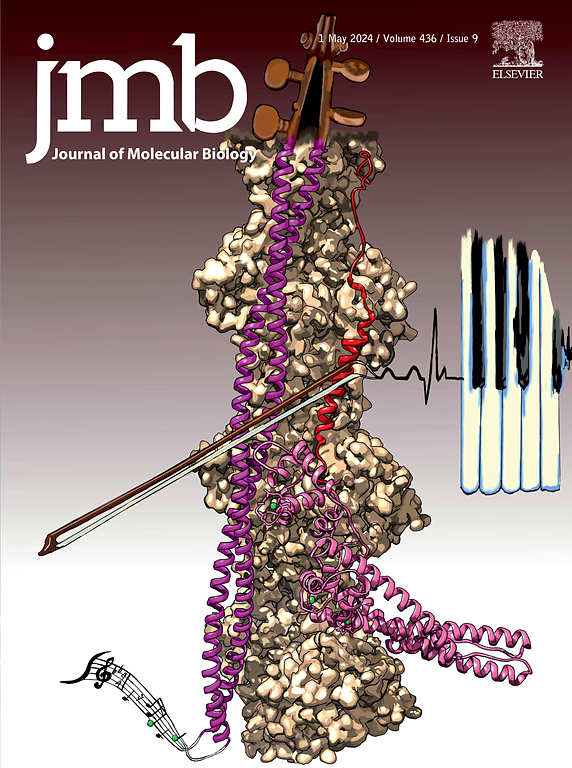Cryo-EM Detection of AMPylated Histidine Implies Covalent Catalysis in AMPylation Mediated by a Bacterial Effector
IF 4.7
2区 生物学
Q1 BIOCHEMISTRY & MOLECULAR BIOLOGY
引用次数: 0
Abstract
AMPylation is a post-translational modification (PTM) whereby adenosine monophosphate (AMP) from adenosine triphosphate (ATP) is transferred onto protein hydroxyl groups of serine, threonine, or tyrosine. Recently, an actin-dependent AMPylase namely LnaB from the bacterial pathogen Legionella pneumophila was found to AMPylate phosphate groups of phosphoribosylated ubiquitin and Src family kinases. LnaB represents an evolutionarily distinct family of AMPylases with conserved active site Ser-His-Glu residues. Here, we capture the structure of the LnaB-actin complex in a putative intermediate state via single-particle cryogenic electron microscopy (cryo-EM) and find that the catalytic histidine of LnaB is covalently attached to AMP through a phosphoramidate linkage at the Nδ1 atom. This observation provides direct structural evidence of histidine AMPylation as a PTM and implies the possibility of covalent catalysis in LnaB-mediated AMPylation, a mechanism distinct from known AMPylases. Subsequent biochemical studies confirm the observed AMP binding site and provide additional insights into the catalytic properties of LnaB. Together, our work highlights the power of cryo-EM in capturing labile PTMs and transient species during enzymatic reactions, while opening new avenues of mechanistic investigation into the LnaB family.

ampyylation组氨酸的低温电镜检测表明在细菌效应介导的ampyation共价催化。
腺苷化是一种翻译后修饰(PTM),其中来自三磷酸腺苷(ATP)的一磷酸腺苷(AMP)被转移到丝氨酸、苏氨酸或酪氨酸的蛋白质羟基上。最近,一种来自嗜肺军团菌的肌动蛋白依赖性氨酰化酶(LnaB)被发现能够磷酸化磷酸化泛素和Src家族激酶的磷酸基。LnaB代表了一个进化上独特的ampylase家族,具有保守的活性位点Ser-His-Glu残基。在这里,我们通过单粒子低温电子显微镜(cryo-EM)捕获了假定处于中间状态的LnaB-actin复合物的结构,并发现LnaB的催化组氨酸通过Nδ1原子的磷酸化键共价附着在AMP上。这一观察结果提供了组氨酸氨酰化作为PTM的直接结构证据,并暗示了lnab介导的氨酰化共价催化的可能性,这是一种不同于已知氨酰化酶的机制。随后的生化研究证实了观察到的AMP结合位点,并为LnaB的催化特性提供了更多的见解。总之,我们的工作突出了低温电镜在酶促反应中捕获不稳定PTMs和瞬态物种的能力,同时为LnaB家族的机制研究开辟了新的途径。
本文章由计算机程序翻译,如有差异,请以英文原文为准。
求助全文
约1分钟内获得全文
求助全文
来源期刊

Journal of Molecular Biology
生物-生化与分子生物学
CiteScore
11.30
自引率
1.80%
发文量
412
审稿时长
28 days
期刊介绍:
Journal of Molecular Biology (JMB) provides high quality, comprehensive and broad coverage in all areas of molecular biology. The journal publishes original scientific research papers that provide mechanistic and functional insights and report a significant advance to the field. The journal encourages the submission of multidisciplinary studies that use complementary experimental and computational approaches to address challenging biological questions.
Research areas include but are not limited to: Biomolecular interactions, signaling networks, systems biology; Cell cycle, cell growth, cell differentiation; Cell death, autophagy; Cell signaling and regulation; Chemical biology; Computational biology, in combination with experimental studies; DNA replication, repair, and recombination; Development, regenerative biology, mechanistic and functional studies of stem cells; Epigenetics, chromatin structure and function; Gene expression; Membrane processes, cell surface proteins and cell-cell interactions; Methodological advances, both experimental and theoretical, including databases; Microbiology, virology, and interactions with the host or environment; Microbiota mechanistic and functional studies; Nuclear organization; Post-translational modifications, proteomics; Processing and function of biologically important macromolecules and complexes; Molecular basis of disease; RNA processing, structure and functions of non-coding RNAs, transcription; Sorting, spatiotemporal organization, trafficking; Structural biology; Synthetic biology; Translation, protein folding, chaperones, protein degradation and quality control.
 求助内容:
求助内容: 应助结果提醒方式:
应助结果提醒方式:


